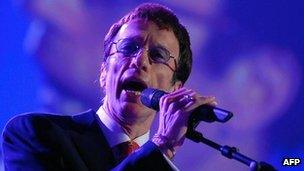Stayin' alive - does music have a role in CPR?
- Published

Music by the Bee Gees has been recommended to help people perform CPR
Can a bit of the Bee Gees help people perform CPR after someone's heart has stopped beating?
Following the beat of Stayin' Alive has been recommended in the past to help people perform the correct number of chest compressions each minute - as has Nellie the Elephant.
However, using these tracks can lead to compressions which are too shallow, studies show.
Experts now argue that better alternatives are now available.
They want research into the field to come to an end.
Correctly performed CPR (cardio-pulmonary resuscitation - or mouth-to-mouth) is lifesaving and is thought to triple survival rates.
The UK Resuscitation Council recommends, external that the chest is compressed by 5-6 cm and at a rate of 100-120 compressions per minute.
Look elsewhere
Performing CPR to Stayin' Alive was recommended in the US as the song contains 103 beats per minute.
Nellie the Elephant had been recommended in the UK. A study, external published in 2009 showed that using the song as an aid did increase the number of people getting the right rate. But there was a drop in those hitting the correct depth.
Now a study, published in Emergency Medicine Journal, external, has investigated Achy Breaky Heart, by Billy Ray Cyrus, and Disco Science, by Mirwais. It showed more than a third of compressions were still too shallow.
The authors concluded: "When considering the combined importance of correct depth and rate, the authors are unconvinced that music provides any benefit in improving the quality of CPR compared with a metronome or audible feedback, suggesting that this interesting but unproductive area of resuscitation research should be discontinued."
The St John Ambulance said training aids can prove helpful.
"Although first aid training doesn't advocate using music to perform CPR, we have found that sometimes people struggle to get the correct number of chest compressions needed per minute and that a training aid, such as a certain musical beat, can help people identify the rate.
"To be effective, both the rate and depth of chest compressions have to be right and we use other training aids to ensure that individuals get the right depth."
The lead author of this study, Prof Malcolm Woollard, said music was not necessarily a bad tool and that "anything that encouraged people to intervene was a good thing".
"Any form of CPR is better than none at all," he added.
However, he said technology was moving on and devices can sense the pressure and rate of chest compressions, even some smartphones, could be used.
Dr Jasmeet Soar, chair of the Resuscitation Council (UK), said: "I agree with the authors that alternative prompt and feedback devices are probably better than music for improving the rate and depth of chest compressions given to patients with cardiac arrest.
"More importantly, if someone has collapsed, is unconscious and unresponsive, and not breathing or just making occasional gasps, dial 999 and start chest compressions. Push hard at about two compressions per second.
"After 30 chest compressions, give two rescue breaths if you are trained - if not, just carry on giving chest compressions until expert help arrives."
- Published18 October 2010
- Published15 October 2010